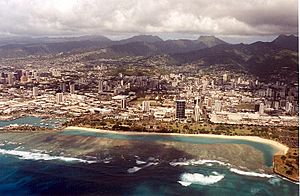Ala Moana Beach Park facts for kids

Ala Moana Beach Park is a fantastic public park in Hawaii, located on the island of Oahu. You can find it between the famous Waikiki area and downtown Honolulu. This huge park is about 100 acres (0.4 km²) big. It has a long, golden sand beach that stretches for over half a mile (800 m).
A shallow reef offshore protects the beach. This makes it a very popular place for swimming in the ocean. About 4 million people visit the park every year! Be careful though, some parts of the reef have sharp corals. Most people prefer the east end of the beach. This area is closer to Diamond Head and has a sandy ocean bottom with no reef or rocks. The middle and west parts of the beach have rocks, making it a bit trickier to get into the water. Lifeguards are always on duty every day to keep everyone safe.
The ocean bottom at Ala Moana drops quickly. So, if you're not a strong swimmer, be careful. The park also has big grassy areas, banyan trees, and palm trees. It's a great spot for picnics, barbecues, playing ball games, or going for a run. You'll find lifeguards, showers, restrooms, phones, tennis courts, picnic tables, and places to buy food. There's even a music pavilion! Ala Moana Beach Park is a favorite place for people who live in Honolulu. It's also right next to "Magic Island", where many fun cultural events happen.
The park closes from 10:00 p.m. to 4:00 a.m.
Contents
History of Ala Moana Beach Park
Ala Moana Regional Park, as we see it today, was not always like this. It was built on land that was once a swampy marsh. In the 1920s, this area was a wetland with lots of plants and trees. The city even used it as a garbage dump back then.
The land was given to the U.S. government. Then, in 1927, it was given back to Hawaii and the city of Honolulu. The only rule was that it had to be used as a public park for everyone.
Building the Park
In 1931, the Parks Board decided to start building the park. They called it Moana Park at first. The Hawaiian Dredging Company helped by filling in the marsh. They used material, including coral reef, that they dug up from the ocean.
The park slowly grew. They added a sports pavilion, a lawn bowling green, and a Banyan tree garden. The pavilion has cool murals and sculptures made by Marguerite Louis Blasingame.
Dredging also created two ponds and canals. These helped drain natural water from the area. At first, there was no beach, and swimming was not encouraged because of nearby sewage pipes.
Official Opening and New Features
President Franklin Delano Roosevelt officially opened the park in 1934. More parts of the park were finished in 1937. This included the Sports Pavilion, Banyan Garden, and tennis courts. These projects were part of a big government effort to create jobs during tough economic times. Local workers built walls and terraces using a special method. It allowed them to use cheap materials and simple tools.
During World War II (1941-1946), the park was used by the military. They built barracks and temporary forts there.
A New Name and a Beach
In 1947, the Parks Board changed the park's name to Ala Moana. This means "path to the sea" in Hawaiian. The beach itself was created later, in 1954. The deep swimming area in front of the beach was actually a boat channel. It was dug through the coral reef in the late 1920s.
In 1955, the Hawaiian Dredging Company closed off the west end of this channel. This created the land for what is now Kewalo Basin Park. From 1957 to 1961, more improvements were made. They added concession stands and bathrooms.
The Story of Magic Island
A man named Henry Kaiser once suggested building a "magic island" with hotels and pools. The existing park would have become a parking lot. Luckily, this big plan didn't happen.
Magic Island was built in 1962. It was made by filling in 30 acres of shallow reef. Developers called it Magic Island. It was supposed to be the first part of a huge resort. But people protested, and the project stopped after just this one island was made. The state turned it into a public park instead. In 1972, the state officially renamed it 'Aina Moana, meaning "land from the sea." This name recognized that the park was made from dredged coral. But most people still call it Magic Island!
McCoy Pavilion was added in 1975. It's named after Charles Lester McCoy, who helped create the park in the 1930s. This pavilion is used for special events today, like the annual Greek Festival.
In 1988, the park was added to the Hawaii State Register of Historic Places. This means it's an important historical site.
Future Plans for the Park
The city of Honolulu has suggested some plans to improve Ala Moana Beach Park and Magic Island. These plans include changes to parking and adding more sand to the beach. They also want to fix up the canals, ponds, and McCoy Pavilion. There are also plans to repair bridges and park entrances. They want to make it easier for people to walk around the park.
Some of the proposed changes, like parking and adding a dog park, have caused some debate. The city has changed the plans and asked for more public opinions. As of November 2018, the city is still looking at what people have said.

